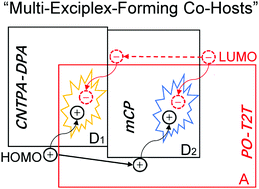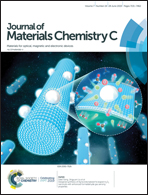High-efficiency exciplex-based white organic light-emitting diodes with a new tripodal material as a co-host†
Abstract
Exciplex-forming co-hosts have been reported to be a potentially suitable material for organic light-emitting diodes (OLEDs). However, they might not be able to provide optimal low voltage and maximal power efficiency (PE), when used in white organic light-emitting diodes (WOLEDs). Herein, a novel strategy using multi-exciplex-forming co-hosts (MEHs) is introduced to achieve enhanced efficiency and low operating voltage. To realize this strategy, a new tripodal bipolar compound CNTPA-DPA was synthesized and used as a co-host in the devices. As a result, the orange light-emitting component in WOLEDs provides 27% external quantum efficiency (EQE), 2.1 V turn-on voltage, and 115.5 lm W−1 PE, which are among the best values of orange color emission in OLEDs. And then this orange light emitting component was adopted in the MEH strategy to construct WOLEDs, achieving 19.5% EQE and 73 lm W−1 PE at the maximum, which are 45.7% and 19.6% higher than those using a single exciplex as the host, respectively. Moreover, the well-matched energy alignment endows the device with a very low operating voltage of 3.8 V at 1000 cd m−2. These results indicate that the performance of the exciplex-based WOLEDs can be remarkably enhanced by using the MEH strategy.



 Please wait while we load your content...
Please wait while we load your content...